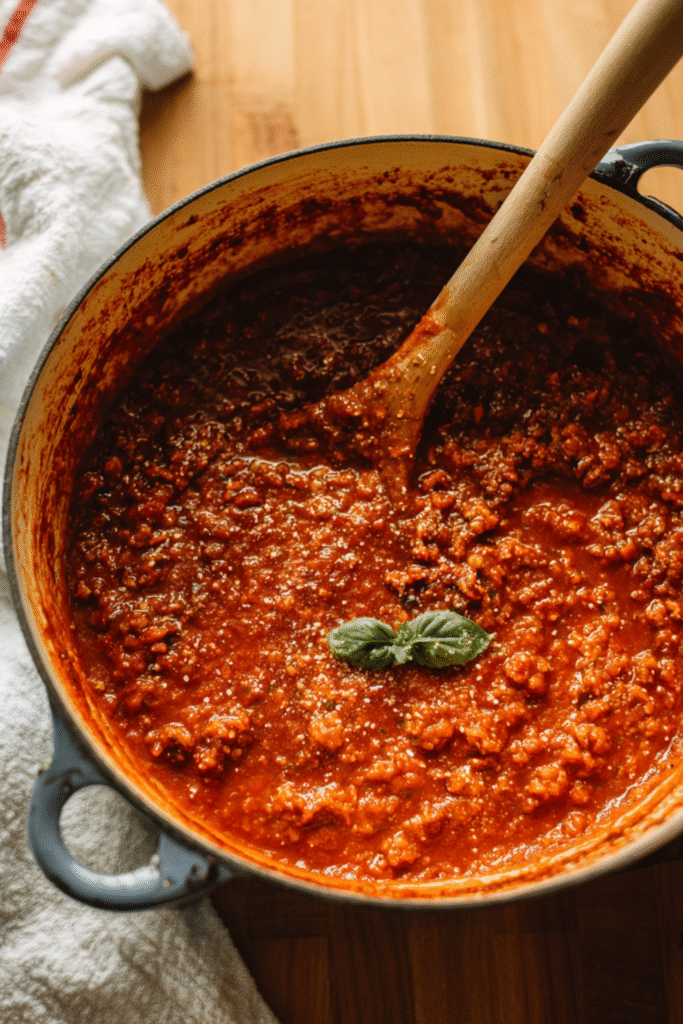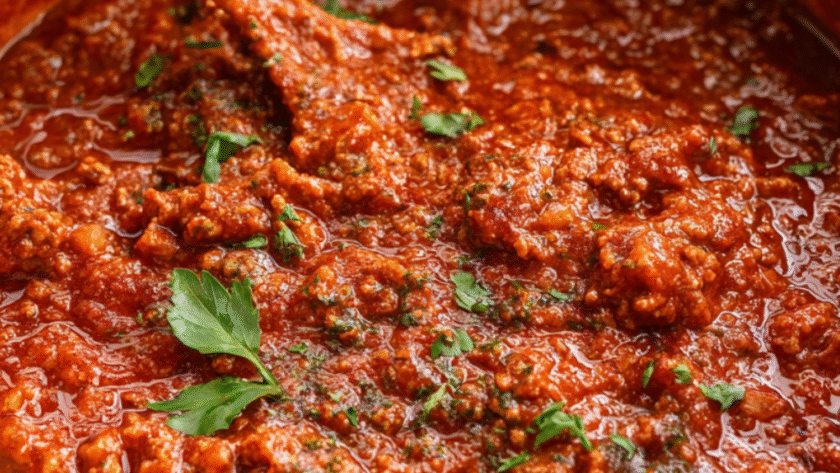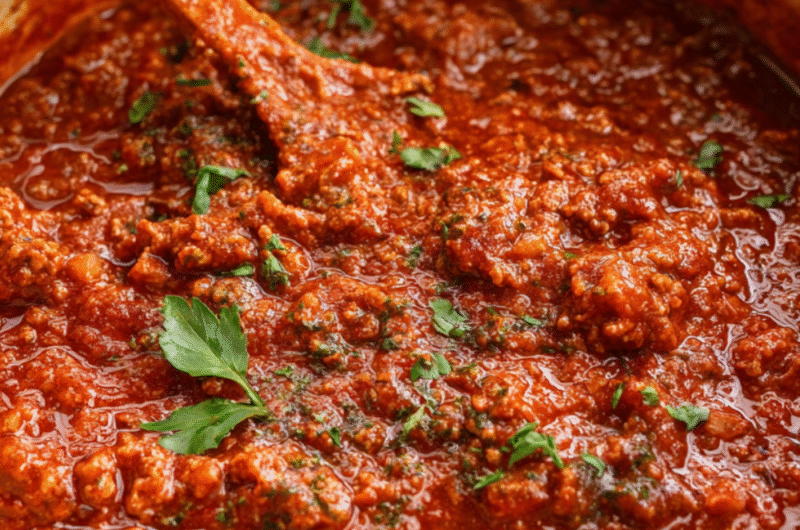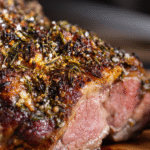This Gordon Ramsay’s Bolognese is a rich and slow-simmered recipe, which is made with pancetta and a mix of ground beef and pork. It’s the ultimate comfort food recipe, ready in about 2 hours and 20 minutes.
Jump to RecipeGordon Ramsay’s Bolognese Sauce Ingredients
- 150g carrots, finely chopped
- 100g onion, finely chopped
- 150g celery, finely chopped
- 3 cloves garlic, minced
- 225g pancetta (or bacon), chopped
- 450g ground beef
- 450g ground pork
- 240ml (1 cup) dry white wine (or red wine)
- 820g (1 large 28-oz can) crushed tomatoes
- 115g (about ½ cup) tomato paste
- 480ml (2 cups) chicken broth
- 240ml (1 cup) whole milk
- Salt and freshly ground black pepper, to taste
- Olive oil, for cooking
How To Make Gordon Ramsay’s Bolognese Sauce
- Prepare the Soffritto: Finely chop the carrots, onion, celery, and garlic. This aromatic base is called a “soffritto” and is the foundation of the sauce’s flavor. You can do this by hand or pulse them in a food processor.
- Crisp the Pancetta: In a large, heavy-bottomed pot or Dutch oven, cook the chopped pancetta over medium heat for 5–6 minutes, until it becomes crispy and has rendered its fat. Remove the pancetta with a slotted spoon and set it aside, leaving the rendered fat in the pot.
- Brown the Meats: Add the ground beef and ground pork to the pot. Cook until browned, breaking up the meat with a spoon as it cooks.
- Combine and Deglaze: Stir the cooked pancetta and the chopped vegetable mixture into the browned meat. Pour in the wine and use a wooden spoon to scrape up any flavorful browned bits from the bottom of the pan. Let the wine simmer and reduce for a few minutes.
- Simmer the Sauce: Add the crushed tomatoes, tomato paste, and chicken broth to the pot. Stir everything together until well combined. Bring the sauce to a gentle simmer, then reduce the heat to low.
- Slow-Cook: Let the sauce simmer gently, uncovered or partially covered, for at least 2 hours, stirring every 20-30 minutes to prevent it from sticking.
- Finish with Milk: During the last 15 minutes of cooking, slowly stir in the whole milk. This adds a final layer of richness and tenderness to the sauce.
- Season and Serve: Season the bolognese with salt and pepper to your taste. Serve warm, tossed with your favorite pasta and topped with freshly grated Parmesan cheese.

Recipe Tips
- How to get the richest flavor? The most important step is to let the sauce simmer for the full 2 hours, or even longer. This long, slow cook time is what allows all the flavors to meld together and develop a deep, rich, and complex taste.
- Why add milk to bolognese? Adding milk at the end is a classic Italian technique. It helps to tenderize the meat and adds a subtle richness and creaminess that balances the acidity of the tomatoes. Don’t skip it!
- Why finely chop the vegetables? Finely chopping (or even mincing) the carrots, celery, and onion allows them to melt into the sauce during the long simmer, creating a smooth, rich texture rather than a chunky one.
- What does “deglazing” do? Those browned bits that get stuck to the bottom of the pan after cooking the meat are pure, concentrated flavor. Deglazing with wine lifts them off the pan and incorporates them into your sauce, making it significantly more delicious.
What To Serve With Bolognese Sauce
This classic Italian meat sauce is traditionally served with thick, sturdy pasta shapes that can hold the hearty sauce.
- Pappardelle or Tagliatelle
- Rigatoni or Penne
- Served over creamy polenta
- With a side of warm, crusty garlic bread
How To Store Bolognese Sauce
- Refrigerate: Store leftovers in an airtight container in the refrigerator for up to 4-5 days. The flavor is often even better the next day.
- Freeze: Bolognese sauce freezes beautifully. Let it cool completely, then store it in freezer-safe containers or bags for up to 3 months. Thaw overnight in the refrigerator before reheating.
- Reheat: Reheat the sauce gently in a saucepan over low heat until warmed through.
Bolognese Sauce Nutrition Facts
- Calories: 250kcal
- Protein: 15g
- Fat: 15g
- Carbohydrates: 10g
- Sodium: 700mg
Nutrition information is estimated and may vary based on ingredients and cooking methods used.
FAQs
Can I use just ground beef instead of a mix?
Yes, you can use all ground beef. However, the combination of beef and pork is classic for a reason; the pork adds a wonderful richness and tenderness to the sauce.
Can I make this in a slow cooker?
Absolutely. Follow the first four steps on the stovetop (through deglazing with wine). Then, transfer everything to a slow cooker and cook on low for 6-8 hours. Stir in the milk during the last 30 minutes of cooking.
Can I use red wine instead of white?
Yes. While white wine is traditional in a classic Bolognese from Bologna, many modern versions use red wine for a deeper, more robust flavor. Either will be delicious.
Try More Recipes:
- Gordon Ramsay Tartar Sauce Recipe
- Gordon Ramsay Madeira Sauce Recipe
- Gordon Ramsay Cranberry Apple Sauce Recipe
Gordon Ramsay’s Bolognese Sauce Recipe
Course: SaucesCuisine: Italian-InspiredDifficulty: Easy8
servings20
minutes2
hours250
kcalA rich and authentic, slow-simmered Italian meat sauce with pancetta, a mix of beef and pork, wine, and a touch of milk for ultimate tenderness.
Ingredients
150g carrots, 100g onion, 150g celery, 3 cloves garlic (all finely chopped)
225g pancetta, chopped
450g ground beef & 450g ground pork
240ml white or red wine
820g crushed tomatoes
115g tomato paste
480ml chicken broth
240ml whole milk
Salt and pepper
Directions
- Sauté pancetta until crisp. Remove from pot.
- Brown the ground beef and pork in the rendered fat.
- Stir in the finely chopped vegetables and the cooked pancetta.
- Deglaze the pot with wine, scraping up the browned bits from the bottom.
- Stir in the crushed tomatoes, tomato paste, and chicken broth.
- Bring to a simmer, then cook on low for 2 hours, stirring occasionally.
- During the last 15 minutes, slowly stir in the milk. Season to taste with salt and pepper.
- Serve hot with pasta and Parmesan cheese.
Notes
- The long, 2-hour simmer is essential for developing a deep, rich flavor.
- Adding milk at the end is a classic technique that tenderizes the meat and balances the sauce.
- Finely chopping the vegetables helps them melt into the sauce for a better texture.
- This sauce freezes exceptionally well for future meals.




